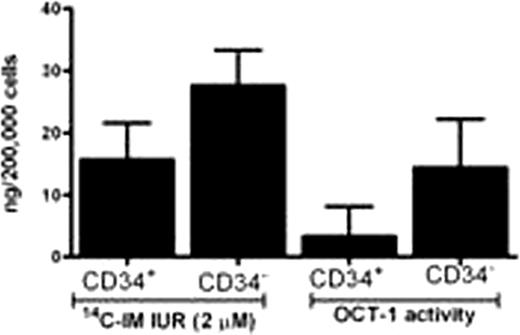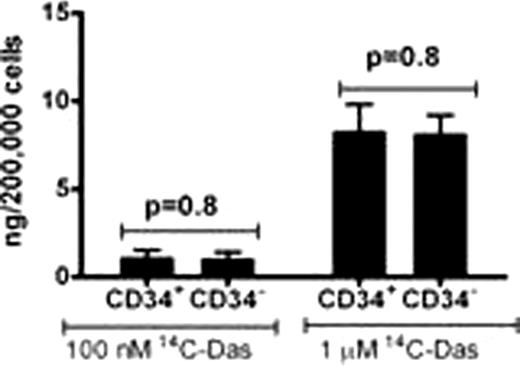Abstract
Abstract 1205
Long term follow up of imatinib (IM) clinical studies and in vitro studies suggest that tyrosine kinase inhibitors (TKI) do not eradicate leukemic stem cells. Refractoriness of leukemic stem cells is postulated to be due to inadequate Bcr-Abl kinase inhibition which in turn could be due to low intracellular uptake and retention (IUR) of TKI. We have previously demonstrated that IM cellular uptake is predominantly mediated by the organic cation transporter protein (OCT-1) and patients with low OCT-1 activity have suboptimal response as compared to patients with high OCT-1 activity. More recently Engler et al (Leukemia 2010) demonstrated that IM IUR is significantly lower in CML-CD34+ cells compared to CD34- cells. This could be due to low expression and activity of the OCT-1 protein and/or high expression of ABCB1 and/or ABCG2 (Jiang et al Leukemia 2007). Although dasatinib is clinically available there are no published data assessing dasatinib IUR in CML-CD34+ progenitors. We and others have previously demonstrated that dasatinib cellular uptake is predominantly OCT-1 independent and dasatinib is a substrate of ABCB1 and ABCG2. We hypothesized that dasatinib IUR would be lower in CML-CD34+ cells compared to CD34- cells. In this study we compare dasatinib and IM IUR; and OCT-1 and ABCB1 mRNA expression in CML-CD34+ and CD34- cells of newly diagnosed CML-CP patients. CD34+ and CD34- cells were incubated with 14C-dasatinib (100 nM and 1 μM) or 14C-IM (2 μM) for 2h and IUR was assessed as described previously (Hiwase et al Clin Cancer Res. 2008). As shown previously, the OCT-1 expression and activity was lower in CML-CD34+ cells, and resulted in lower IM IUR in CML-CD34+ cells compared to CML-CD34- cells (15±5 vs. 27±5; p=0.04; Fig 1A and C). However at a therapeutically achievable concentration (100 nM dasatinib) and at higher concentration (1 μM dasatinib), there was no significant difference in dasatinib IUR in CML-CD34+ and CD34- cells (Fig 1B). Low OCT-1 expression and activity in CML-CD34+ cells did not influence the dasatinib IUR; further confirming that dasatinib cellular influx is predominantly OCT-1 independent. Despite higher ABCB1 mRNA expression in CML-CD34+ cells, the dasatinib IUR was not lower in CML-CD34+ cells compared to CD34- cells. High ABCB1 mRNA expression may not necessarily translate into high ABCB1 activity. To this end, we assessed the effect of PSC-833, an ABCB1 inhibitor, on dasatinib IUR and dasatinib mediated Bcr-Abl kinase inhibition in CML-CD34+ cells. The baseline p-Crkl, a surrogate marker of Bcr-Abl kinase activity, was significantly higher in CML-CD34+ compared to CML-CD34- cells (67±5% vs. 55±8%; p=0.002; n=9). PSC-833 neither increased dasatinib IUR, nor enhanced dasatinib mediated Bcr-Abl kinase inhibition in CML-CD34+ cells (% p-Crkl at 10 nM dasatinib: 20±6 vs. 27±10). Similarly, Ko143, an ABCG2 inhibitor, did not significantly change dasatinib IUR or Bcr-Abl kinase inhibition (% p-Crkl at 10 nM dasatinib: 21±3 vs. 27±10). In summary, although dasatinib is an ABCB1 and ABCG2 substrate, ABCB1 and ABCG2 inhibitors neither increase dasatinib IUR, nor enhance dasatinib mediated Bcr-Abl kinase inhibition in CML-CD34+ cells. This data suggest that dasatinib IUR in CML-CD34+ cells is not influenced by ABCB1 and ABCG2. Hatziieremia et al (Exp. Hematology, 2009) reported that ABCB1 activity is low in CML-CD34+ cells and suggested that it did not influence IM level in CML-CD34+ cells. We further demonstrated that 100 nM dasatinib inhibited ≥95% Bcr-Abl kinase activity in CML-CD34+ and CD34- cells.
In summary our data demonstrates that in contrast to IM, the intracellular concentration of dasatinib is equivalent in mature and immature CML cell compartments which may contribute to better targeting of early CML progenitors with dasatinib.
In contrast to IM, dasatinib intracellular uptake and retention (IUR) is not significantly different in CML-CD34+and mature CD34-cells: (A) OCT-1 activity and IM IUR is significantly lower in CML-CD34+ than CD34- cells (p=0.04). (B) However, dasatinib IUR is not significantly different in CD34+ and CD34- cells (p=0.8) (C) OCT-1 mRNA expression is lower in CML-CD34+ cells than CD34- cells. While ABCB1 expression is significantly higher in CML-CD34+ compared to CD34- cells (p=0.007).
In contrast to IM, dasatinib intracellular uptake and retention (IUR) is not significantly different in CML-CD34+and mature CD34-cells: (A) OCT-1 activity and IM IUR is significantly lower in CML-CD34+ than CD34- cells (p=0.04). (B) However, dasatinib IUR is not significantly different in CD34+ and CD34- cells (p=0.8) (C) OCT-1 mRNA expression is lower in CML-CD34+ cells than CD34- cells. While ABCB1 expression is significantly higher in CML-CD34+ compared to CD34- cells (p=0.007).
White:Novartis: Honoraria, Research Funding; BMS: Research Funding. Hughes:Novartis: Honoraria, Research Funding; Bristol-Myers Squibb: Honoraria, Research Funding.
Author notes
Asterisk with author names denotes non-ASH members.




This feature is available to Subscribers Only
Sign In or Create an Account Close Modal